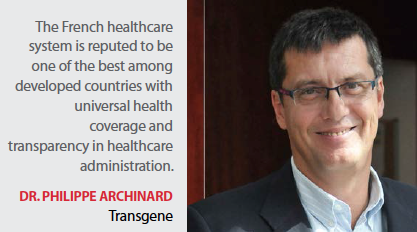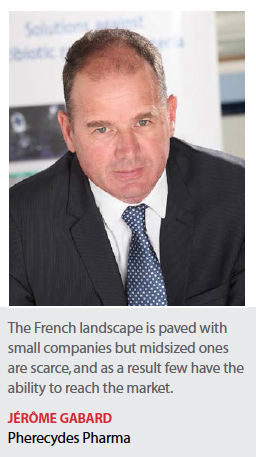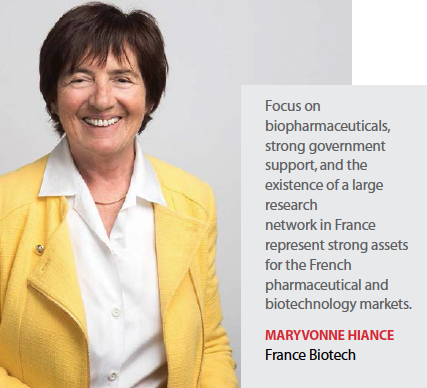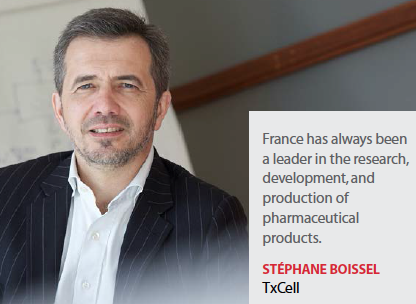France is the second-largest European market and one of the world’s largest consumers of pharmaceutical products.
The French pharmaceutical industry grew by 17.9% between 2000 and 2010, compared with growth of 6.1% in the manufacturing sector.
 This performance can be explained by solid scientific, industrial and economic advantages, and by the dynamism of its players of all sizes, says Philippe Archinard, Ph.D., CEO of Transgene and chairman of Lyon Biopôle.
This performance can be explained by solid scientific, industrial and economic advantages, and by the dynamism of its players of all sizes, says Philippe Archinard, Ph.D., CEO of Transgene and chairman of Lyon Biopôle.
However, according to GlobalData, the French pharmaceutical market is expected to grow by just 0.7% CAGR from $46.2 billion in 2014 to $48.2 billion by 2020, mostly due to an increasing focus on generic drugs. Despite the negative impact of generics, France’s pharmaceutical market will be boosted by a number of factors, including an aging population, tax incentives, a substantial skilled workforce and high public healthcare expenditure.
For the last 10 years, like many other leading global healthcare markets, the French pharmaceutical market has been experiencing several external and internal pressures, says Maryvonne Hiance, chairman of France Biotech, the association of French biotechnology and life-sciences companies, and VP of the board and strategic director of OSE Immunotherapeutics. These include rising R&D expenses, patent expiries, and increasing regulatory and pricing/reimbursement constraints.
“As a result, pharmaceutical companies have increased their focus on generic drug development, emerging markets, and M&A strategies," Ms. Hiance says.
According to Deloitte analysts, the life-sciences sector in France is expected to face a challenging year this year. The government has focused on cutting the rate of reimbursement on many drugs, removing a number from health insurance system coverage, and promoting the use of generics. In addition, life-sciences regulatory enforcement is likely to intensify, with the competition authority, the Autorité de la concurrence, becoming increasingly assertive.
Life-sciences companies also will face obstacles created by a new market access (MA) requirement. The French pharma industry’s competitiveness has weakened and the country’s attractiveness as an R&D site is eroding, despite a very generous research tax credit scheme.
The Evolving Pharma Picture
 France has long been a leader in the research, development, and production of pharmaceutical products, thanks to high-quality scientific and engineering education and a strong industry that includes such companies as Sanofi, Servier, Ipsen, and Pierre Fabre, says Stéphane Boissel, CEO of biotech company TxCell.
France has long been a leader in the research, development, and production of pharmaceutical products, thanks to high-quality scientific and engineering education and a strong industry that includes such companies as Sanofi, Servier, Ipsen, and Pierre Fabre, says Stéphane Boissel, CEO of biotech company TxCell.
However, experts note that there has been a reduction in terms of R&D by large pharma companies. There is very little breakthrough R&D taking place at French pharmaceutical companies, with most developments being fixed-dose combination products, says Kimty Bui-Van, head of function, regulatory affairs, ProductLife Group.
Pipeline renewal has been one of the major concerns of pharmaceutical companies, many of which are increasingly turning to M&A transactions, strategic diversification as well as deals and R&D collaborations with biotechnology companies, Ms. Hiance says.
French biotech company Innate Pharma has entered into alliances with AstraZeneca, Bristol-Myers Squibb, and Sanofi to advance its immuno-oncology pipeline. Pfizer and Servier are both working with Cellectis on new cancer treatments based on CAR T-cells, while Eli Lilly has inked an agreement with Adocia to further develop a technology designed to accelerate insulin absorption.
“In addition, there have been several significant acquisitions, such as the acquisition of Trophos by Roche and Ipsogen by Qiagen," Mr. Boissel says.
Foreign companies seeking to enter the French market face specific challenges.
“Those companies must have an exploitant, which is a very specific role," Ms. Bui-Van says. “This person needs to have a pharmaceutical establishment license, they should have a qualified person, called a responsible pharmacist, and the exploitant is accountable for distribution and marketing of the medicinal product onto the French market, for medical information, and for pharmacovigilance. So whenever a foreign company wants to get onto the French market they have to have this exploitant on the ground, as well as a local qualified person for pharmacovigilance."
While in 2010 the majority of drug R&D and production was carried out by the largest French pharma companies, this trend is now shifting, Ms. Hiance says.
“In 2015, French biotech companies had more products in development in their pipeline than the largest four pharma players combined — Sanofi, Ipsen, Servier, and Pierre Fabre," she says.
According to Dr. Archinard, an aging population and the need for better treatments against severe diseases and better management of chronic diseases, have opened opportunities for biotech companies to develop innovative solutions, and as such these companies have become more numerous, better funded, and more mature.
Over the past 10 years, the French biotech R&D market has emerged as the leading European market, as exemplified by the number of companies listed on the Euronext market — from a handful in 2006 and a combined market cap below €500 million ($564.6 million) to now more than 50 life-sciences companies listed with a combined market cap of more than €10 billion, according to Mr. Boissel.
Jérôme Gabard, chief operating officer of Pherecydes Pharma, notes that while there are many small companies in France, there are few mid-sized pharma companies, which means few have the ability to reach the market and funds are insufficient.
 “Business angels are fairly active and tend to invest in innovation more quickly and are willing to take more risks than standard life-science venture capital funds," Mr. Gabard says. “Raising private funds is particularly difficult, however, public funding whether at a national or European level, is fairly strong."
“Business angels are fairly active and tend to invest in innovation more quickly and are willing to take more risks than standard life-science venture capital funds," Mr. Gabard says. “Raising private funds is particularly difficult, however, public funding whether at a national or European level, is fairly strong."
Ms. Hiance says government support for research in life sciences is strong, and cites the creation of competitiveness clusters (pôles de compétitivité) in 2005 as an example.
“These clusters bring together public academic research and private research to promote market developments and foster innovation," she says.
Dr. Archinard says of the 71 innovation clusters in France, seven are dedicated to healthcare and life sciences, and have been created to translate academic research into innovation. More than 6,500 companies belong to these clusters, including 670 foreign companies.
“These innovation clusters, along with other government policies such as direct subsidies, tax exemptions, and tax credits really drive innovation," Dr. Archinard says.
“For example, a Research Tax Credit (Crédit Impôt Recherche, CIR) offers corporate tax relief based on R&D expenses incurred by firms operating in France. It covers 40% of R&D expenses in the first year, 35% in the second year, and 30% in subsequent years up to €100 million ($139 million), and is doubled for R&D outsourced to public-sector laboratories."
“In 2013, the CIR tax credit represented a total of €6 billion," Mr. Boissel says. “For TxCell, it reached €3 million for the year 2015, which is a significant amount for a company like ours."
Ms. Hiance adds that the ‘Jeune Entreprise Innovante’ (Young Innovative Company) status, initiated by France Biotech in 2004 and targeting young companies with fewer than 250 employees and spending at least 15% of total expenses on R&D, offers several advantages such as a reduction in employer contributions as well as favourable tax incentives.
Given challenges that French biotech and medical technology companies face when raising funds with private investors during later stages of development, more mature companies are turning to foreign investors (especially U.S. investors) to fund their research.
Dr. Archinard notes that public investment bank Bpifrance has been more involved in funding companies at all stages of development, together with local private equity funds.
“In parallel, the numerous IPOs of the last years have led to an increased appetite of French investors for healthcare companies," he says. “These companies have capitalized on their increased visibility to attract European and US-based specialized funds, before meeting success and being acquired."
“Continued government support through tax incentives combined with increasing collaboration deals with pharmaceutical companies and fair valuation during initial public listing should help these biotech companies secure the necessary funds for program development and subsequent organic growth or in some cases a merger or an acquisition," Ms. Hiance says.
Pharma Innovation
Research and development in life sciences and healthcare have always been one of France’s strongpoints, Ms. Hiance says.
The country has a highly skilled workforce and a large network of both private and academic research institutions. France is particularly well recognised in the areas of in vitro diagnostics, vaccine development, and immunoth erapy.
erapy.
“In 2015, most R&D programs undertaken by French biotechnology companies were in the areas of oncology, infectious diseases, and the central nervous system," she says, noting that a third of French biotech companies are focusing on oncology.
“France has worldwide biotech leaders in fields such as cellular immunotherapy, immuno-oncology, diabetes, and allergy," Mr. Boissel says.
In oncology, immune checkpoint blockers have shown efficacy, Dr. Archinard says, and the goal for many companies, including Transgene, is to increase the rate of patients responding to these treatments.
“To achieve this, the industry is now focused on finding the right therapeutic agents that can be combined with these checkpoint inhibitors," he says.
In other areas, Pherecydes Pharma was founded to focus on phage therapy to address antibiotic resistance. The company is a spin-off from Paris-based Bio-Modeling Systems, which works on information systems and models to address some of the major issues in health sciences.
Bio-Modeling had run a system on the antibiotic resistance problem and found that phage technology could be used to control and kill bacteria. Pherecydes is the first company to have launched a multicenter European phage therapy clinical trial using Western pharmaceutical and clinical standards, to evaluate phage therapy on infected burn wounds. The first patient was enrolled in July 2015 in France.
The company chose to conduct trials in France and other French-speaking European countries because of the work that needed to go into training the medical team on a new therapeutic approach, and the importance of working in a common language.
“Not all nurses read and understand English," Mr. Gabard says. “This is one of the reasons that led us to choosing French-speaking burn units in France, Belgium, and Switzerland."
Cost was another determining factor. Under the French national health system, the only cost incurred during a clinical trial is the extra cost generated by the trial, Mr. Gabard says. All costs that are required for the patient standard care are paid for by the national health system.
“For third-degree hospitalized burn patients, these costs are really high," he says.
In addition, the French regulatory authority, the National Agency for Medicines and Health Products Safety (ANSM), provides extensive scientific, manufacturing, and clinical advice, and for experts involved in medicinal or medical device developments, all regulatory meetings with and recommendations from ANSM are free of charge, Mr. Gabard says.
Another growing area in France is medical technology, and these companies are increasingly collaborating with both national and international players to develop companion diagnostics, Ms. Hiance says.
“The development of e-health solutions is another major trend on the French healthcare market," she says. “Information systems and software represent the largest share of the French e-health market while digital and interconnected tools are expected to grow with an annual growth rate of 4% to 7% by 2020."
Approval and Reimbursement
For products approved under the Centralised Procedure, which include Advanced Therapy Medicinal Products, there is no difference among European countries in terms of marketing authorization. Other approval processes include the Decentralised Procedure and the Mutual Recognition Procedure.
Once a treatment has been approved, companies must negotiate its price and reimbursement separately in each country. As the French government aims to reduce the Social Security deficit, price and reimbursement are very sensitive topics in France, Mr. Boissel says.
Mr. Gabard agrees, noting there is a push to reduce the costs by the national health and health insurance bodies.
“The reimbursement of very expensive therapies is at risk of being significantly reduced," he says.
“Reimbursement rates can have a major impact on the commercial success of a drug and non-reimbursed medicines are much harder to sell, especially if there is a reimbursed alternative for the same indication," he says. “A number of drugs have even been delisted over the past decade as their therapeutic value was considered insufficient by the regulator."
The push to lower prices and move to generic products is taking place across Europe, Ms. Bui-Van says, adding that when there is a medicine that is a true medicinal breakthrough, authorities in France are keen to promote access to these medicines and would accept the allocation of high pricing for these medicinal products that provide a true benefit to patients.
France was a relatively late entrant to the generics market compared to the UK and Germany. In 2008, generic drugs accounted for 21.7% of the pharmaceutical market in terms of volume, which increased to 30.2% in 2013, according to GlobalData.
GlobalData analytics say the French government is promoting generics as a measure to reduce healthcare expenditure. In September 2012, it introduced a scheme under which patients who agree to generic substitution will not be required to pay for their drugs.
Ms. Bui-Van notes that the timeframe for getting a new marketing authorization assessed in France is two years or more. She says that the hold-up is due to huge backlog of dossiers that have not been assessed.
As a result, France is now used less frequently as the Rapporteur or co-Rapporteur for the centralized procedure as they are not compliant to assessment timelines, Ms. Bui-Van says.
Mr. Gabard says the ANSM is fairly open to innovation, supporting new approaches and helping companies to maneuver through the regulatory landscape.
“This is valuable especially when new medical approaches are non-existent in the European Pharmacopeia, such as phage therapy," he says.
At the patient level, Mr. Boissel says a number of campaigns and incentives have been launched to encourage patients to limit their drug usage and to take generics whenever possible.
“For instance, pharmacists are encouraged to systematically replace branded drugs with their generic alternative when they deliver prescription medications," he says. “Patients may object but then have to pay the extra cost of the branded product."
However, when it comes to innovative drugs for life-threatening diseases and drugs with high unmet need, patients benefit from relatively quick access through Temporary Authorization for Use (Autorisations Temporaires d’Utilisation, ATU), Dr. Archinard says.
“This system allows these drugs to be used in hospitals even before they are registered," he says. “The growth in demand for innovative medicines in the main therapeutic areas will enable such therapies to command a premium price and influence the value of the French pharmaceutical market." (PV)



















